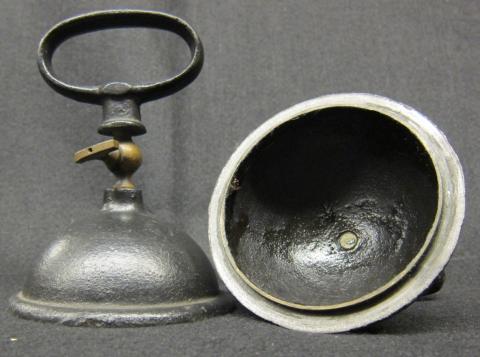Media
Magdeburg hemispheres
Magdeburg hemispheres
Text
Made of cast iron and lined with grease, the Magdeburg hemispheres at Dickinson College tell the tale of early pneumatic demonstrations in university science lecture halls. The hemispheres are miniatures of those used by Otto von Guericke in his 17th century demonstration of the power of the vacuum.
Guericke’s original hemispheres were over a foot in diameter, and when evacuated could not be pulled apart by teams of horses. While the inseparable hemispheres were stunning for audiences, horses could not be practically brought into the classroom. To replicate the demonstration in the lecture hall, laboratory models of the hemispheres were much smaller. The apparatus at Dickinson is only a few inches in diameter, and was evacuated by way of a hose connected to a tabletop air pump.
Miniature Magdeburg hemispheres could be used in numerous ways, demonstrating the basic tenets of air pressure. Students could attempt to pull the hemispheres apart, to no avail, as the air pressure within the sphere was lower than that in the room, and would require significant strength to separate. For the same reason, weights suspended from the bottom hemisphere would not pull the apparatus apart. The hemispheres are only separable after air had been let back into the chamber via a valve at the top of the device.
The miniature Magdeburg hemispheres are one of the many apparatuses used at Dickinson for pneumatic demonstrations. Engaging students by pitting human strength against pneumatic science, the hemispheres engaged audiences of students and the public, feeding into the showmanship that was so central to scientific lectures of the time. Just like their initial use in front of the Holy Roman Emperor, the Magdeburg hemispheres displayed in grand fashion the power of the vacuum and the allure of pneumatic chemistry.
For Further Reading:
Ede, Andrew, and Lesley B. Cormack. A History of Science in Society: From Philosophy to Utility. Toronto: Broadview Press, 2004.
Turner, Gerard L'Estrange. Nineteenth-Century Scientific Instruments. London: Sotheby Publications; Berkeley: University of California Press, 1983.
Warner, Deborah Jean. 1987. "Air Pumps in American Education." Physics Teacher 25: 82-85.

